Truth is Stranger than Fictional Characters: Dolly Varden in the 1870s
By Emily McCort, 2019 Summer Fashion Archives Intern
During the mid-nineteenth century, people fell in love with Dolly Varden. She became so popular that suddenly anything and everything was named after her, including various types of music, a fish (the Dolly Varden Trout, specifically), a hat, and a style of dress. Godey’s Lady’s Book, an American magazine that featured news on the latest fashions, shared in a publication that “A ‘DOLLY VARDEN Cough Elixir’ is announced, Dolly Varden horseshoe, Dolly Varden dog collar, Dolly Varden razor strops, and, running the thing in the ground, are Dolly Varden metallic coffins.” [1]. There was even a small political party and an all African-American, all-female baseball team named after her.
What’s so fascinating about this obsession that spanned Britain and the United States for a brief time in the nineteenth century is that Dolly Varden was not even a real woman.
Dolly Varden is a fictional character in Charles Dickens’ novel, Barnaby Rudge. She is portrayed as a young, flirtatious, well-dressed woman who ends up marrying Joe Willett, another character in Barnaby Rudge. So why did so many people in the nineteenth century become obsessed with someone who was basically a side character in one of Dickens’ least popular novels?
Although researching Dolly Varden can be tricky due to the numerous things bearing her name, the character appears to have gained popularity after the artist William Powell Frith painted her in 1842 in a “fancy portrait,” a specific portrait style that depicted fictional characters. While this painting was commissioned in the 1840s, the Dolly Varden craze occurred between 1865 and 1875.
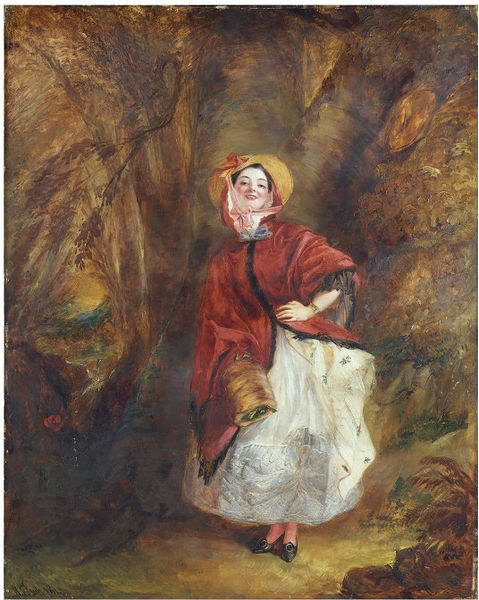 |
| William Powell Frith, Dolly Varden, 1842. F.8. The Victoria and Albert Museum. Gift of John Forster. |
For such an incredibly popular trend, there is very little information written today about it. Most information on the Dolly Varden style came from sources written at the time of the trend, most specifically from Godey’s Lady’s Book. From 1865 to 1875, and then briefly in the 1880s, there were at least two fashion trends that were named after Dolly Varden: a particular hat and a dress constructed in the eighteenth century à la polonaise style. Finding images of an actual Dolly Varden hat proved difficult, but, according to Godey’s Lady’s Book, the hats were flat and low with an “ear cluster of rosebuds under the brim and another above the forehead.” [2] Surprisingly, many of the visual sources that exist of this costume come from sheet music covers. Polkas, waltzes, and marches that bore the name Dolly Varden in their titles included an image of her.
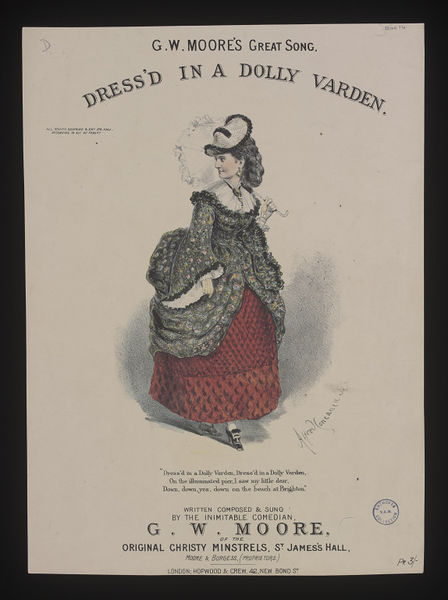 |
| Example of a Dolly Varden hat on a sheet music cover. |
| Dress’d in a Dolly Varden. ca. late 19th century – early 20th century. S.194-2012. The Victoria and Albert Museum. Gift of Gabrielle Enthoven Collection. |
In addition to the hat, two variations of the Dolly Varden dress existed. In the 1870s, there are references to the Dolly Varden polonaise, a style inspired by the eighteenth century robe à la polonaise, a dress constructed with hidden or displayed drawstrings that looped the over-skirt into decorative swags. Because Barnaby Rudge takes place in the 1770s, the Dolly Varden dress’s antiquated construction works perfectly.
The other variation is the Dolly Varden fancy dress where people dressed in a manner more typical of the portraits and images of Dolly Varden for parties. While this fancy dress could probably be worn at any costume party, Godey’s Lady’s Book specifically references an eighteenth century themed bash where “Marie Antoinette and her surroundings at the Trianon were represented by a party who were all friends; Watteau peasants and Dolly Varden costumes were most popular.” [3]
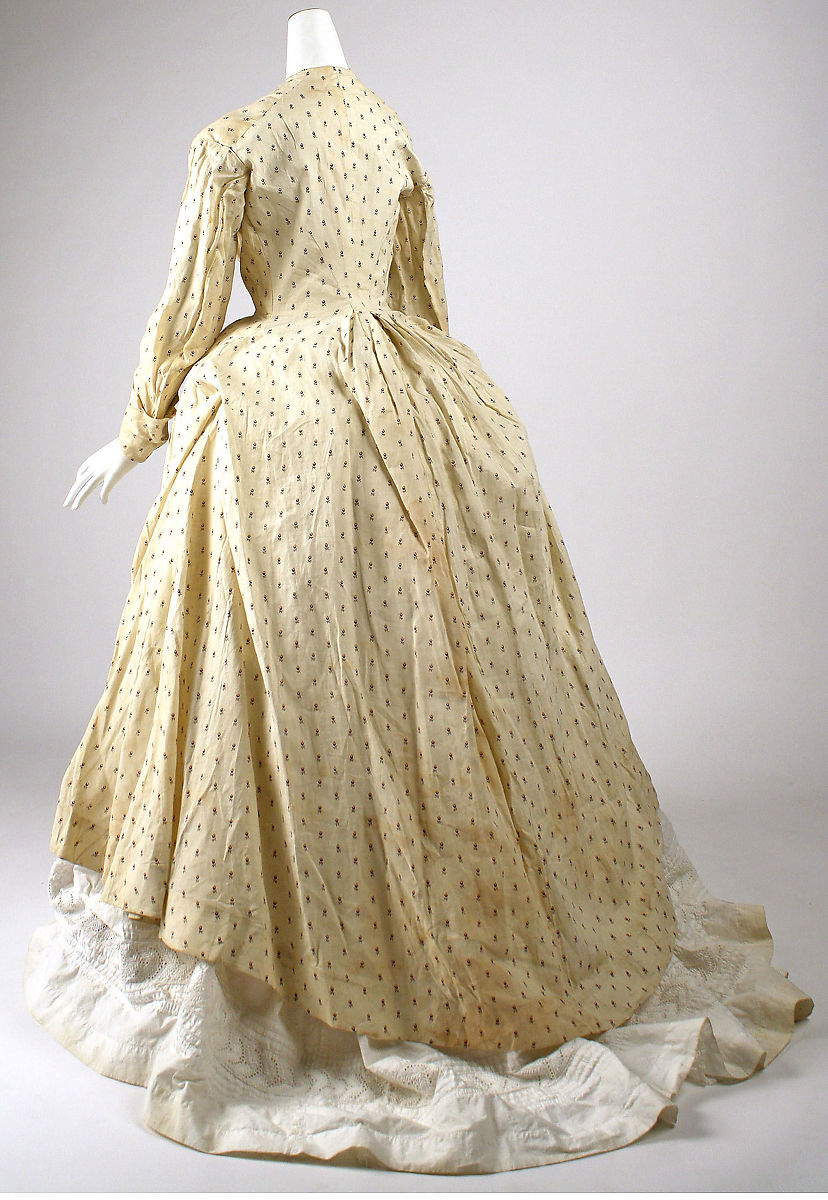 |
| Example of an 1865-1875 Polonaise Dress. |
| Robe à la Polonaise (1865–75). C.I.X.54.10.6. The Metropolitan Museum of Art. Gift of Professor Talbot Hamlin |
Fichus, which were neckerchiefs worn in the eighteenth century, also appear to be popular during this Dolly Varden craze and were worn both with the regular dress and the fancy costume.
Barnaby Rudge and subsequent illustrations depict Dolly Varden as being colorfully dressed. In the Dolly Varden painting and following images, her polonaise overskirt is typically red or has a red print.
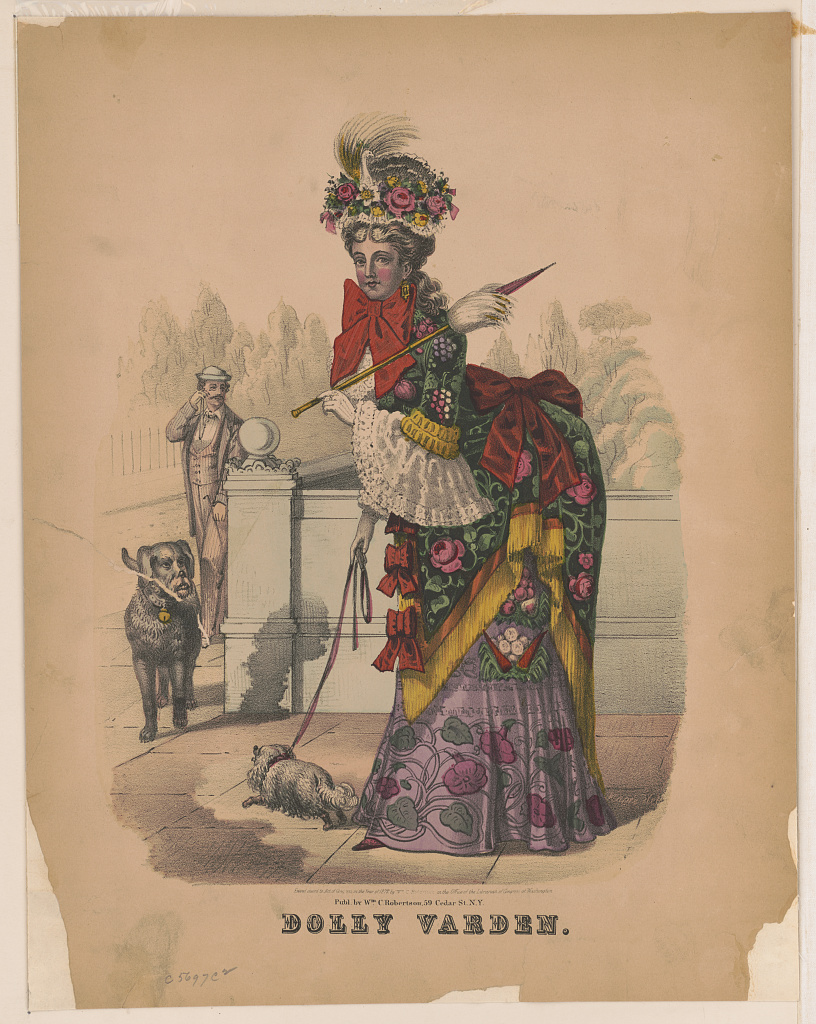 |
| Dolly Varden. Photograph. 2003679801. Library of Congress. |
Both versions of the Dolly Varden dress were typically made of a printed calico or linen, usually with a floral motif. This may be due to the fact that these fabrics were affordable and accessible. The following excerpt, pulled from Godey’s Lady’s Book‘s August 1880 publication, is a letter that mentions a quilting group where a group of young women wish to sew Dolly Varden dresses:
They say there is plenty of curtain calico down to the store, and that Mr. Snipsus, the storekeeper, will sell it cheap, for it has been on his hands a long time, but now it will be just the thing to make Dolly Vardens out of. Some of it has large tropical leaves and flowers on it, and some has great bunches of magnified hollyhocks and peonies, and I don’t know what all [3].
The 1870s polonaise style dress housed in the Maryland Historical Society’s Fashion Archives is a natural linen that features a bright red floral motif. Based on the dress’s date and patterned fabric, it is possible that this dress is an example of a Dolly Varden.
 |
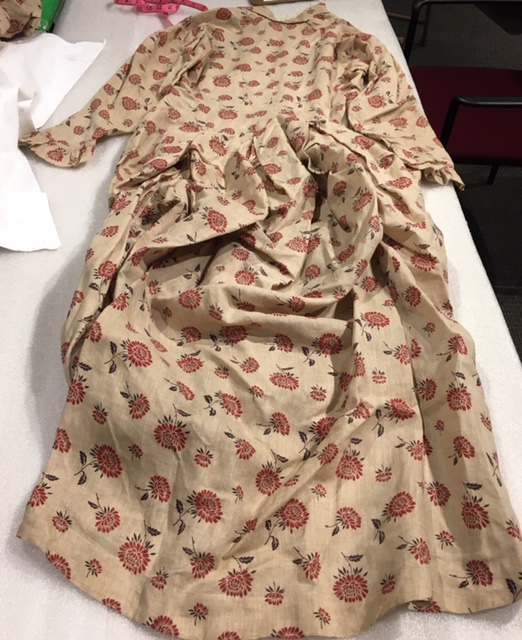 |
| Example of an 1870s Polonaise Dress |
| Maryland Historical Society, Gift of Mrs. Robert Garrett. 1950.42.10. |
Sources:
[1] Godey’s Lady’s Book, July 1872. Accessible Archives, 2019. Accessed July 5, 2019.https://accessible.com/accessible/emailedURLAADoc=GODEYSLADYSBOOK.GO1872070047.04963
[2] Godey’s Lady’s Book, July 1872. Accessible Archives, 2019. Accessed July 5, 2019.https://accessible.com/accessible/emailedURLAADoc=GODEYSLADYSBOOK.GO1872070055.04971
[3] Godey’s Lady’s Book, August 1880. Accessible Archives, 2019. Accessed July 5, 2019.https://accessible.com/accessible/emailedURLAADoc=GODEYSLADYSBOOK.GO1880080037.03237
Other Sources:
Dress’d in a Dolly Varden. ca. late 19th century – early 20th century. S.194-2012. The Victoria and Albert Museum. Gift of Gabrielle Enthoven Collection. https://collections.vam.ac.uk/item/O1244326/dressd-in-a-dolly-varden-music-concanen-alfred/
“Dolly Varden.” Tate Museum. Accessed July 5, 2019. https://www.tate.org.uk/art/artworks/frith-dolly-varden-t00041
Dolly Varden. , ca. 1872. Photograph. https://www.loc.gov/item/2003679801/.
Kinkel, C. DollyVarden march. Brainard & Sons, S., Cleveland, monographic, 1872. Notated Music. https://www.loc.gov/item/sm1872.07222/.
Pickles, Cathy and Blattman, Elissa. “Jackie Mitchell and the Bloomer Girls: Baseball’s Unsung Heroines.” National Women’s History Museum. Accessed July 5, 2019. https://www.womenshistory.org/articles/jackie-mitchell-and-bloomer-girls
Robe à la Polonaise (1865–75). C.I.X.54.10.6. The Metropolitan Museum of Art. Gift of Professor Talbot Hamlin. https://www.metmuseum.org/art/collection/search/100159
“The Dolly Varden Absurdity.” Daily Alta California, Volume 27, Number 9266, 17 August 1875. California Digital Newspaper Collection. Accessed July 5, 2019. https://cdnc.ucr.edu/?a=d&d=DAC18750817.2.48&e=——-en–20–1–txt-txIN——–1
William Powell Frith, Dolly Varden,1842. F.8. The Victoria and Albert Museum. Gift of John Forster. https://collections.vam.ac.uk/item/O80877/dolly-varden-oil-painting-frith-william-powell/

